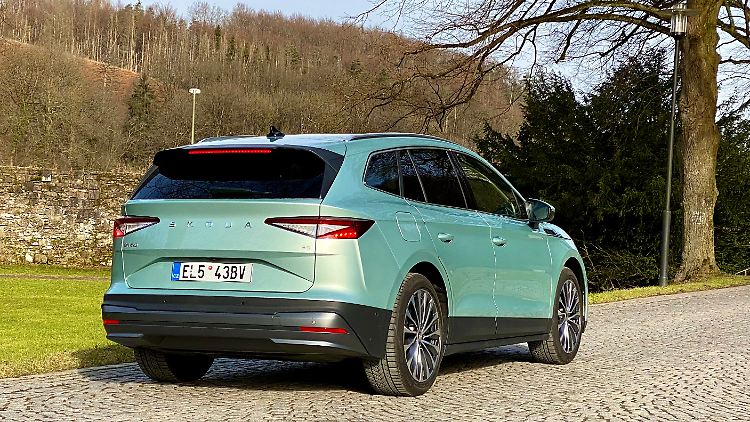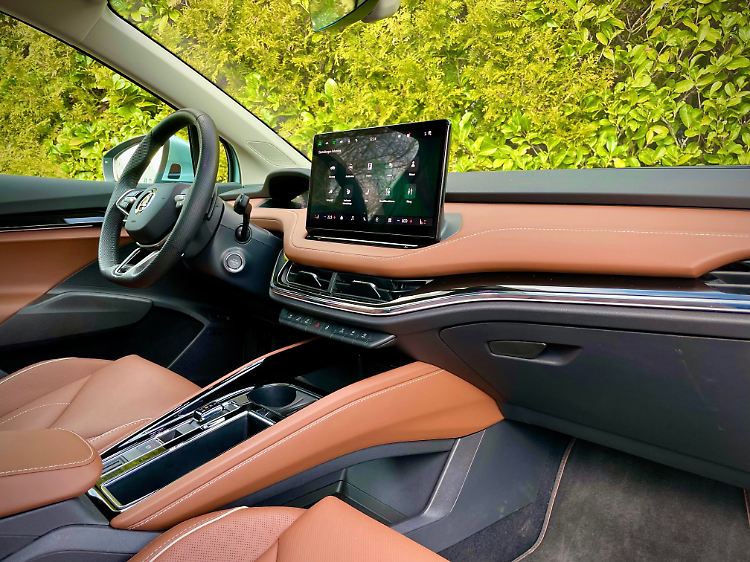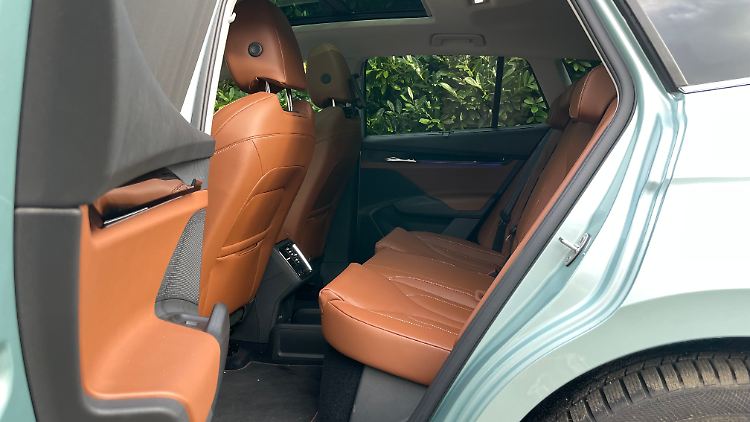Škoda probably offers the most elegant version of the MEB Group compact van. And its name Enyaq is nice. But what does MEB actually mean? Read for yourself.
It is always said that electric cars are terribly expensive. Sure, no electrically powered vehicle currently comes close to the petrol bargains à la Dacia Sandero or Mitsubishi Space Star for just over 11,000 euros. But affordable electric mobility with a high level of practicality for children and adults – is that possible? The Volkswagen Group is at least making an effort and is offering the playful-looking ID.4 under the Volkswagen brand from 40,335 euros on its website. Not a bargain rate, but not incredibly unaffordable either.


What you can't see in daylight: The radiator grille is equipped with a fine light strip that lights up noticeably at night.
(Photo: Patrick Broich)
And what about the Škoda brand, which is considered cheap? It also offers a compact model based on the same technology – but the price makes you sit up and take notice. The Czechs are charging no less than 48,900 euros for the 4.65 meter long multifunctional vehicle called Enyaq. The elegant all-rounder is reminiscent of the Bentley Bentayga, especially with its rear. It is also based on the modular electrical system (MEB), the current chassis for the cheaper corporate electric vehicles. The platform is designed for rear-wheel drive, but can also accommodate two engines, which is combined with all-wheel drive. There are limits to the charging power of this 400-volt architecture. There is also the technically cool Audi Q4 E-Tron as well as a visually sporty version of this category called Tavascan from Cupra.


The Enyaq rear is reminiscent of the much larger and more expensive Bentley Bentayga. It shouldn't bother customers much.
(Photo: Patrick Broich)
In contrast to the ID.4, the Enyaq currently does not have less than 286 hp – that has little to do with a well-behaved family carriage. The Volkswagen base only produces 170 hp, just to say the least. In return, the Czech naturally gains a boost in sovereignty and shines with performance that was previously more likely to be attributed to sports cars. The electric unit, which is equipped with 545 Newton meters of torque, balances the 2.2-ton truck up to country road speed within 6.7 seconds. This feels correspondingly dynamic for the passengers, with gentle pressure on the small of their back.
At the same time, the engineers have made the more powerful engine (previously 204 hp) more economical; According to WLTP, the Enyaq now uses three kilowatt hours less per 100 kilometers (from 13.5 kWh). Škoda puts the WLTP range at 427 to 607 kilometers – and this range shows that handling electric vehicles is not that easy. The reproducibility of charging power and range does not exist with electric vehicles, at least to the same extent as with combustion engines; the user has to live with this reality.
Electric vehicles require some getting used to handling


A large central screen is hardly worth mentioning today. The stylish decorative seams in this class do. But it was too early to be happy: they are of course not standard.
(Photo: Patrick Broich)
Things like outside temperature and additional consumers (heating and air conditioning) have a big influence on how far you can actually drive. After all, the Enyaq test car had a real range of around 500 kilometers with a full battery in fairly cold weather at the beginning of the year. But only if you drive cautiously. For efficiency reasons, ntv.de opted for the single-engine variant with rear-wheel drive (the 286 hp version is also available with all-wheel drive).
And the charging performance? In the practical test, the Enyaq 85 with 77 kWh net capacity charged from 15 to 45 percent within 17 minutes – with this performance it would break the 28 minutes specified by the factory from 10 to 80 percent, but the charging station also has to play along – the keyword is reproducibility . However, it should be emphasized that the major charging brands such as Aral Pulse, ENBW or Shell usually ensure that their charging stations deliver the promised performance.


Traveling in the second row is first-class thanks to plenty of knee room.
(Photo: Patrick Broich)
The bottom line is that the Enyaq is a rewarding practical car with excellent long-distance capability and quite luxurious features. The medium-sized SUV has balanced suspension and has variable damping with an electronically adjustable characteristic curve for an additional charge.
The cognac-colored leather seats of the test car also create a noble impression. Not only do they look stylish, they also offer very solid driving comfort. And they are really nice high-tech chairs with air conditioning and massage functions. There are also elegant decorative seams even in the fittings area. However, such luxury costs a few thousand extra, that should be clear.


Lots of cargo space (1710 liters) give the Enyaq a practical touch.
(Photo: Patrick Broich)
However, the Enyaq's generous amount of space, which is particularly noticeable for rear passengers, comes at no extra cost. Good packaging is evident here: Although the Skoda does not have a sprawling wheelbase of 2.76 meters, it still has a veritable interior size. This is also supported by the values for the trunk volume. If you fold down the rear seat backs, the Enyaq can take a lot of luggage with you (1710 liters).
The Czech electric SUV also has “Simply Clever”
And what about the “Simply Clever features” typical of the brand? The ice scraper has moved from the fuel filler flap (on combustion engines) to the tailgate area. There are also additional multifunctional hooks in the trunk or various tailor-made boxes. And in the trunk the user will still find his cargo elements to secure his cargo as well as the variable cargo space floor – but it costs an extra 360 euros. And the umbrella can also be found in the front door, of course.


In contrast to the front, the seat heating at the rear can be switched on using a classic push button. Sometimes conventional things are better than supposed progress.
(Photo: Patrick Broich)
The infotainment, which is already quite decent from the factory, can be spiced up with a head-up display by spending money. However, the 13-inch touchscreen is always on board. An improved operating system is now running here, which at least stands out for its quick response and intuitive menu navigation. The fact that not every user wants to touch, but some people would like to have physical switches, apparently left Škoda indifferent. The consequence of this is a row of buttons below the large screen. But please don't expect too much. The main thing is that the menus for the relevant function groups (e.g. assistance or air conditioning) can be called up on the screen using the buttons.
At least some functions can be activated directly using the touch buttons. These include automatic parking, windshield defrosting and rear window heating. In the rear this also includes the seat heating, while at the front it is switched on on a permanent virtual bar on the monitor. This often only works with a delay, especially shortly after the start. Design also has more priority than function with the Enyaq.
Data sheet Škoda Enyaq iV 85
|
Dimensions (length/width/height) |
4.65 / 1.88 / 1.62 m |
|
wheelbase |
2.76m |
|
Empty weight (DIN) |
2137kg |
|
Seating |
5 |
|
loading volume |
585 to 1710 liters |
|
Engine type |
A permanently excited synchronous machine |
|
Gearbox |
A fixed translation |
|
Performance |
286 hp (210 kW) |
|
drive |
Rear wheel drive |
|
max. torque |
545 Nm |
|
Acceleration 0-100 km/h |
6.7 seconds |
|
Top speed |
180 km/h |
|
Battery capacity |
77 kWh (net) |
|
Maximum charging power (direct current) |
135kW |
|
Charging power (alternating current) |
11kW |
|
Charging time (10 to 80%) |
28 minutes |
|
Consumption (combined) |
13.5 to 19.2 kWh/100 km (WLTP) |
|
combined WLTP range |
427 to 607 kilometers |
|
Combined CO₂ emissions |
0g/km |
|
Basic price |
From 48,900 euros |
Conclusion: The Škoda Enyaq is a successful and, above all, comfortable all-rounder. The fact that the Czechs currently do not have an entry-level model with under 200 hp on offer makes the model expensive. Although the 286 hp variant has a beefy start, less power would also do the trick. The company should do something about charging performance to make the switch mentally easier for people who don't like electric cars. 135 kilowatts of charging power are sufficient for the everyday needs of most drivers. But psychology doesn't cooperate; users want to have the battery filled quickly, just as they are used to with the tank of their combustion engine. Only the successor platform will probably provide a solution. Loading times of twelve minutes (10 to 80 percent) are already circulating online. However, that will still take a few years. And so the current Enyaq has to get going until further notice.































